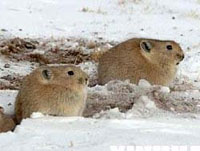Attempts by Chinese authorities to preserve regions like Sanjiangyuan National Nature Reserve do not always appear to be based on sound scientific principles. They tend to lean more toward experimental approaches—with unknown impact. Bound to upset the delicate ecological balance of the Tibetan plateau is a large-scale plan to wipe out pikas.
Pikas, which are relatives of rabbits, are regarded as pests by herders and government alike for their habits of eating vegetation and digging burrows underground. Pikas are being blamed for deteriorating grassland quality, but there is no proof of this—the more likely causes are climate change and overgrazing. In actual fact, pikas may prove to be an essential part of the plateau eco-system: digging by pikas brings up minerals that help plants grow, and their burrows offer shelter to insects that pollinate flowers, as well as offering homes as nesting sites to various birds.
An explosion in the population of pikas comes down to this: Chinese soldiers and settlers have decimated the natural predators of pikas, such as foxes, bears, snow leopards and raptors. Without these predators to keep the pika population in check, their numbers have increased.
The pika poisoning program has been going on for 30 years.
In Qinghai alone, an area of roughly 300,000 square kilometres (including large swathes of Sanjiangyuan) has being targeted for eradicating pikas through use of poison. That's an area the size of Italy. This pika poisoning project has the potential to poison all the mammals and birds in the food chain that prey on pikas—with disastrous results.
